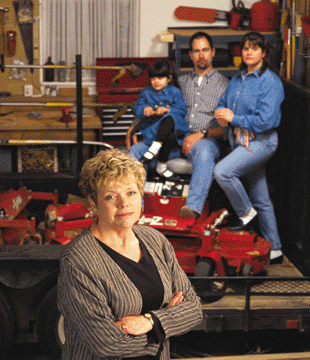
Photo: Jeanne Freibert
New in 1999, the First Line of Defense Award honors the dealers, central stations and emergency authorities that have demonstrated outstanding performance in deterring, detecting or preventing crime and/or loss through the effective design, use and response to security and fire alarm systems.
The award's goal is to publicize the effectiveness of electronic security and life safety systems by recognizing one winner, one runner-up and eight finalists.
In 1999, top honors in the inaugural First Line of Defense Award go to CARE Security & Monitoring, New Albany, Ind.
CARE Security's winning story belongs to Brad and Marcia Allen of Louisville, Ky. The Allen's security system, a Caddx NX-8, includes a carbon monoxide detector by Pama Electronics, Kibbutz Mishmar Hanegev, Israel.
As a direct result of the CO detector and the subsequent actions of CARE's monitoring and other response personnel, the Allens' security system just may have saved their lives. Here's their story, as told by Ellen Smith, vice president, CARE Security; the Worthington, Ky., Fire Department; and system owner Brad Allen.
SMITH: On the evening of August 4, 1998, I received a carbon monoxide detector signal from the home of Mr. and Mrs. Brad Allen. I telephoned the premise and there was no answer.
As directed, I telephoned Brad Allen's mother, Mrs. Phillip Allen, to report the situation. I warned [her] that carbon monoxide is an odorless, colorless gas and that she should call me upon arrival at the home.
At 6:54 p.m. I received intrusion signals (entry/exit and motion signals) from the premise, and there was no answer after attempting to call more than once. I immediately dispatched the police. At 6:55 p.m. the Worthington Fire Department was dispatched to the premise.
WFD: The parents (Phillip and Lorraine Allen) came to the house and found a lawn mower running in the garage. They made a quick check of the house and found no one inside. (The fire department) shut off the mower and vented the house with electric smoke ejectors.
While the house was venting, we performed a thorough secondary search for occupants. None were found. Our CO meter measured readings as high as 857 parts per million (ppm) in the house. We continued venting all levels of the house until our meter showed readings of less than 10 ppm. We made the parents aware of our findings, and they agreed to make the homeowner aware of the situation.
ALLEN: My wife and I came home around 8 p.m. and were shocked that this had happened. The firemen told my parents that my family could not stay in the house that night. The next afternoon we were allowed to re-enter the house after the firemen again checked the carbon monoxide level.
How could this happen? My wife and I are profoundly deaf. I am an architect technician with the Corps of Engineers and have a part-time lawn-mowing company. I accidentally left one of my mowers running. I had just purchased it, and it was different from my other mower; it was very quiet. I did not have my hearing aids on while I was working, and I could not hear the mower when I left it in the garage.
I am thankful that our house has an alarm designed for the hearing-impaired. When my wife and I built our home a few years ago, we installed a complete alarm system with strobe lights to alert us of any danger. CARE Security & Monitoring Company spent a lot of time designing the system for us, and we feel very safe.
My sincere thanks to CARE Security & Monitoring and the Worthington Fire Department. They handled a dangerous situation in a very timely and professional manner and may have saved us and our young daughter from serious injury or death.
Ellen Smith, who typically works the daytime shift, says it was by chance she was at CARE's monitoring center that evening to respond to the alarm.
"(Later,) Mrs. (Lorraine) Allen called me and told me what happened, and it just brought tears to my eyes and goosebumps all over knowing that everything worked out and they were fine," Smith says. "It has to be the highlight of five years of monitoring for me."
Smith says she now uses this experience in training CARE's monitoring staff to realize the far-reaching effects of the job.
She also emphasizes to customers the importance of having a monitored CO detector as opposed to a less expensive, store-bought type.
"I hear stories every week about someone whose CO detector went off and they took out the batteries or unplugged it, and that doesn't solve the problem," she says. "They think it's falsing. (But) you're going to fall asleep if the carbon monoxide gets to a certain level."
According to Brad Allen, the family has had the CO detector since they first bought their security system four years ago.
"(Now) we realize the alarm system for our home is the best thing I ever invested in, and we are very fortunate to have it," Brad Allen says.
The CO detector itself is in the upstairs hallway, with strobe lights for notification in the family room, master bedroom, basement and garage.
The detector was designed to go off at 100 ppm. When the fire department arrived less than a half hour later, it measured the CO level at 857 ppm. If the Allens had no method of detecting the problem, they may have come home, gone to sleep and never awakened.
According to Doug Mosow at the American Lung Association's National Health House Project, St. Paul, Minn., a person's reaction to CO exposure depends on various factors, such as age, health and length of exposure. Origins of carbon monoxide leaks also vary. While the hazard in the Allens' case came from a lawnmower, other sources include cars running in garages, combustion appliances and fireplaces.
Health House was created in 1993 to educate builders and consumers on how to create healthier indoor environments. Mosow says that although he would recommend CO alarms for any home, only about 20 percent of Americans currently use them.
A March 1998 article in the Journal of the American Medical Association (JAMA), attributes about 2,100 deaths and 10,000 illnesses each year to unintentional carbon monoxide poisoning. The article goes on to inform readers that CO detectors could potentially prevent many of these deaths.
Luckily for the Allens, they knew that already.
For additional information on CO and other indoor air quality problems in the home, contact the National Health House office at 800-642-LUNG or visit the Web site at www.healthhouse.org.

Photo: Jeanne Freibert
About 1999 First Line of Defense Award winner CARE Security & Monitoring
In the industry for just five years, CARE Security & Monitoring has wasted no time getting off the ground. The company does it all: selling, installing, monitoring and servicing residential and commercial security systems in the Louisville metropolitan area.CARE offers basics like burglar, fire, access control and CCTV, plus other home systems, such as central vacuum.
With a small, 11-member staff, co-owners David and Ellen Smith plan to keep the company a family operation, says Ellen Smith, CARE vice president.
"We tried another independent business before this, the restaurant business, but you're not helping anyone by serving them a cup of coffee," she says. "Both of us missed (being) in a business where we were helping people."
Given their backgrounds, security wasn't a far stretch for either Smith. David, CARE president, holds a degree in criminal justice and was a police officer for nearly a decade before switching to business. Ellen worked as a paralegal for 20 years.
Currently, CARE Security has about 2,400 accounts, about 2,000 of which are monitored. The company also monitors about 1,000 additional accounts for other alarm dealers. The Smiths' plans for the future are simple: move the business into a permanent building of their own, expand their customer base and watch the business grow.
.png?height=200&t=1647439146&width=200)

